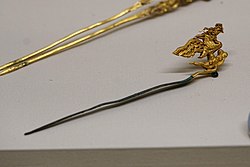 Two styles of Chinese hairpin, zan and chai. | |
| Type | Traditional Chinese hairpin |
|---|---|
| Material | Diverse |
| Place of origin | China, at least since the Neolithic Hemudu culture (5500 BC to 3300 BC) |
'Ji (Chinese: 筓); pinyin: Jī) (also known as Fazan '(Chinese: 髮簪); pinyin: Fà zān), Zanzi or Zan (Chinese: 簪子or簪); pinyin: Zānzi or zān) for short)[1][2] and Chai(Chinese: 钗); pinyin: Chāi) are generic terms for hairpin in China.[3] 'Ji' (with the same character of 笄) is also the term used for hairpins of the Qin dynasty.[4] The earliest form of Chinese hair stick was found in the Neolithic Hemudu culture relics; the hair stick was called Ji (Chinese: 筓); pinyin: Jī), and were made from bones, horns, stones, and jade.[5]
Hairpins are an important symbol in Chinese culture,[1] and are associated with many Chinese cultural traditions and customs.[6] They were also used as every day hair ornaments in ancient China;[3] all Chinese women would wear a hairpin, regardless of their social rank.[7] The materials, elaborateness of the hairpin's ornaments, and the design used to make the hairpins were markers of the wearer's social status.[1][6] Hairpins could be made out of various materials, such as jade, gold, silver, ivory, bronze, bamboo, carved wood, tortoiseshell and bone, as well as others.[3][8][1][9]
Prior to the establishment of the Qing dynasty, both men and women coiled their hair into a bun using a ji.[3] There were many varieties of hairpin, many having their own names to denote specific styles, such as zan, ji, chai, buyao and tiaoxin.[10][3][11]
- ^ a b c d "Hairpins in Society and Art". Hairpin Museum 百鍊鋼化作繞髮柔 髮簪博物館. Retrieved 2021-05-05.
- ^ Wu, Shu-Ling (2019). Mastering advanced modern Chinese through the classics. Haiwang Yuan. Abingdon, Oxon: Taylor & Francis. pp. 125, 233. ISBN 978-1-315-20897-8. OCLC 1053623258.
- ^ a b c d e "Historical hair ornaments and their social connotations". usa.chinadaily.com.cn. Retrieved 2021-05-05.
- ^ Hidden dimensions of education : rhetoric, rituals and anthropology. Werler, Tobias. Wulf, Christoph. Waxmann. 2006. pp. 165–168. ISBN 3-8309-1739-2. OCLC 470776855.
{{cite book}}: CS1 maint: others (link) - ^ "周原遗址出土的骨笄".
- ^ a b "Chinese cloisonne hairpin". collection.maas.museum. Retrieved 2021-05-06.
- ^ "Material & Technology". Hairpin Museum 百鍊鋼化作繞髮柔 髮簪博物館. Retrieved 2021-05-06.
- ^ Sherrow, Victoria (2006). Encyclopedia of hair : a cultural history. Westport, Conn.: Greenwood Press. p. 179. ISBN 0-313-33145-6. OCLC 61169697.
- ^ Yuan, Xiaowei (2017). "Traditional Chinese Jewelry Art: Loss, Rediscovery and Reconstruction Take Headwear as an Example". Proceedings of the 2nd International Conference on Contemporary Education, Social Sciences and Humanities (ICCESSH 2017). Atlantis Press. pp. 550–554. doi:10.2991/iccessh-17.2017.135. ISBN 978-94-6252-351-7.
- ^ Living the good life : consumption in the Qing and Ottoman empires of the eighteenth century. Elif Akçetin, Suraiya Faroqhi. Leiden: Brill. 2018. p. 205. ISBN 978-90-04-35345-9. OCLC 1008768840.
{{cite book}}: CS1 maint: others (link) - ^ "Golden Hairpin Decorated with Character "Shou" - Chengdu Museum". www.cdmuseum.com. Retrieved 2021-05-06.